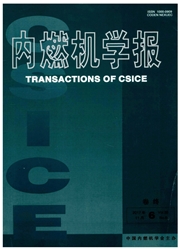

 中文摘要:
中文摘要:
将正丁醇、正庚烷分别与柴油以20∶80和40∶60体积比掺混,在100、130,MPa两个喷油压力下进行柴油机直喷燃烧试验,研究喷油压力和掺混比例对柴油/正丁醇低温燃烧特性和碳烟排放的影响,结果表明:提高喷油压力能够改善柴油/正丁醇掺混燃料高比例EGR燃烧相位滞后问题,在更大EGR率范围实现高效燃烧.随喷油压力提高,十六烷值和含氧对降低碳烟的作用增强,沸点等其他特性作用变小.提高掺混比例,正丁醇对燃烧的影响更明显,燃烧放热始点明显推迟、燃烧反应速度加快,在一定的EGR率范围内热效率提高.掺混比例从20%提高到40%,各燃料特性对碳烟排放的降低作用都显著增大,沸点等其他特性作用成为降低碳烟排放的重要因素,十六烷值的作用更加显著.
 英文摘要:
英文摘要:
Effects of injection pressure and blending ratio on diesel/n-butanol low temperature combus- tion(LTC) and soot emissions were investigated on a heavy-duty diesel engine. Fuels were prepared by blending n-butanol and n-heptane into pure diesel fuel at ratio of 20 : 80 and 40 : 60(in vol- ume)respectively. Injection pressures of 100 MPa and 130 MPa were tested. Results show that, higher injection pressure significantly improves the retarded combustion phase of diesel/n-butanol blended fuel at high EGR rate, thus achieve high-efficiency combustion in larger EGR range. At higher injection pressure, the effects of cetane number and oxygen content on soot reduction are higher, and effects of other fuel properties, such as boiling point, are lower. The effects of n-butanol fuel properties on com- bustion are more significant with the increase of blending ratio. Combustion phase is retarded, combusiton rate is increased, and indicated thermal efficiency is improved within certain EGR range. When blending ratio increases from 20% to 40%, the effects of fuel properties on soot reduction are more significant. Other properties become the important factors on reducing soot emission and the effects of cetane number on soot is more obvious.
 同期刊论文项目
同期刊论文项目
 同项目期刊论文
同项目期刊论文
 Regulated and unregulated emissions from a compression ignition engine under low temperature combust
Regulated and unregulated emissions from a compression ignition engine under low temperature combust Experimental Investigation of Injection Strategies on Low Temperature Combustion Fuelled with Gasoli
Experimental Investigation of Injection Strategies on Low Temperature Combustion Fuelled with Gasoli An Experimental and Numerical Study on the Effects of Fuel Properties on the Combustion and Emission
An Experimental and Numerical Study on the Effects of Fuel Properties on the Combustion and Emission 期刊信息
期刊信息
